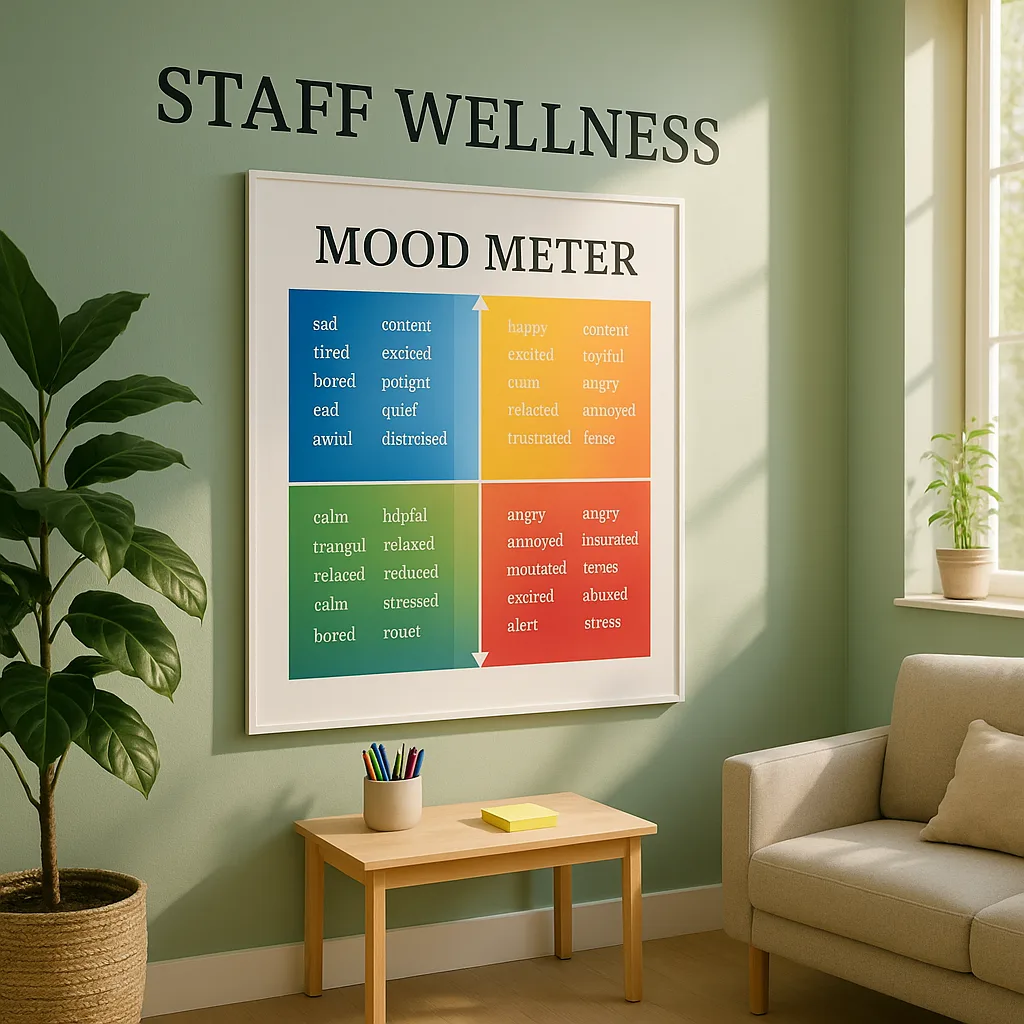Poster Machine for Schools Wellness Stations – Transform Staff Areas
Mindful Mornings: Designing Visual Check-In Stations for Educator Mental Health
Transform your staff areas into sanctuaries of support with evidence-based visual wellness tools that honor educator well-being.
As an educational psychologist who has worked with countless educators across the country, I’ve witnessed firsthand the emotional toll teaching can take. Furthermore, I’ve seen how simple visual tools can create profound shifts in educator well-being. Today, I’m excited to share evidence-based strategies for creating visual wellness check-in stations using a poster machine for schools wellness stations that can transform your staff areas into supportive sanctuaries.
The Science Behind Visual Wellness Check-Ins
Research from the Journal of School Psychology shows that educators who engage in brief morning wellness check-ins report 40% lower stress levels throughout the day. Moreover, visual cues activate different neural pathways than verbal processing, making them particularly effective for busy educators who may be cognitively overloaded.
Dr. Christina Maslach’s groundbreaking work on burnout identifies emotional exhaustion as the primary component affecting educators. Therefore, creating systems that help teachers recognize and address their emotional state before entering the classroom becomes crucial for sustainable practice.

Visual check-in stations serve multiple psychological functions. First, they normalize the conversation around educator mental health. Additionally, they provide concrete tools for self-assessment without requiring extensive time or energy. Most importantly, they create a ritual of self-care that becomes embedded in the daily routine.
Mood Meter Design Principles
The mood meter represents one of the most powerful visual tools for emotional check-ins. Based on the work of Marc Brackett at Yale’s Center for Emotional Intelligence, an effective mood meter combines color psychology with simple navigation.
When creating mood meters with your school poster printer, consider these design principles:
Color gradients should flow naturally from low-energy/unpleasant (blues) through low-energy/pleasant (greens) to high-energy/pleasant (yellows) and high-energy/unpleasant (reds). Furthermore, each quadrant should include specific emotion words that resonate with educator experiences.
The physical placement matters tremendously. Position mood meters at eye level near the staff room entrance but not directly visible from hallways. This placement ensures privacy while making the tool accessible during natural transition times.
Stress-Level Indicators That Actually Work
Traditional stress scales often fail to capture the nuanced experience of educator stress. Instead, visual metaphors prove more effective for quick self-assessment. Consider creating a “Weather Report” stress indicator using your poster machine for schools wellness stations.
This approach uses weather imagery—from sunny skies to gathering storms—to represent stress levels. Research shows that metaphorical representations reduce cognitive load and increase engagement with wellness tools. Additionally, weather metaphors feel less clinical and more approachable for educators who might resist traditional mental health frameworks.
Self-Care Reminder Displays Using Your Poster Machine for Schools Wellness Stations
Self-care reminders work best when they’re specific, actionable, and rotated regularly. Instead of generic “Take care of yourself” messages, create targeted reminders that address common educator challenges.
For instance, design a “60-Second Reset” poster series featuring quick stress-relief techniques. Each poster might include a simple breathing exercise, a desk stretch, or a mindfulness prompt. The key lies in making these practices so accessible that even the busiest teacher can participate.
Using a school poster printer allows you to create seasonal variations that keep the content fresh and relevant. During testing season, focus on anxiety-reduction techniques. Moreover, during parent conference weeks, emphasize boundary-setting and energy conservation strategies.
Maintaining Momentum Without Adding Burden
The greatest challenge in educator wellness initiatives lies in sustainability. However, visual check-in stations succeed precisely because they require minimal maintenance once established.
Create a rotation schedule where different grade levels or departments take monthly responsibility for refreshing the wellness station. This distributed approach prevents any individual from feeling overwhelmed while maintaining fresh content.
Additionally, leverage your school poster printer to create themed wellness campaigns that align with the academic calendar. For example, “Mindful March” might focus on stress reduction before state testing, while “Grateful November” emphasizes appreciation practices.
Morning Mindfulness
5-minute guided practicesImplementation Tips
Create QR codes linking to brief audio meditations. Update monthly with seasonal themes. Position near coffee stations for natural integration into morning routines.Peer Support
Building community careConnection Strategies
Design “Colleague Appreciation” boards where staff leave anonymous notes of encouragement. Refresh weekly to maintain engagement and prevent stagnation.Resource Library
Evidence-based toolsCurated Support
Compile one-page wellness resources addressing common challenges. Topics might include sleep hygiene, nutrition tips, or boundary-setting strategies.Measuring Success and Adjusting Your Approach
Unlike academic interventions, wellness initiatives require gentler assessment methods. Therefore, focus on engagement patterns rather than formal evaluations.
Track which visual tools educators use most frequently. Notice whether certain designs or messages resonate more strongly. Most importantly, observe changes in staff room atmosphere and colleague interactions.
Anonymous suggestion boxes near wellness stations provide valuable feedback without pressure. Questions might include: “What wellness topic would you like to see addressed?” or “Which visual tool has been most helpful for you?”
The Classroom Pro 24 Poster Maker Elite Package includes design software that makes updating your wellness visuals based on feedback quick and efficient.
Creating Lasting Change Through Visual Wellness
The journey toward educator wellness doesn’t require grand gestures or expensive programs. Instead, it begins with simple, consistent practices that honor the emotional complexity of teaching.
Visual check-in stations serve as daily invitations to self-awareness. They normalize conversations about mental health while providing practical tools for emotional regulation. Moreover, they create a culture where educator well-being becomes as important as student achievement.
As you design your wellness stations, remember that perfection isn’t the goal. Rather, aim for authenticity, accessibility, and gentle persistence. Each small step toward self-care ripples outward, ultimately benefiting the entire school community.
Dr. Lauren Mitchell is a licensed educational psychologist specializing in teacher wellness and mental health. This post reflects evidence-based practices from her 12+ years working with school districts nationwide. For more resources on educator well-being, explore our FAQ section or learn about funding options for your wellness initiatives.

